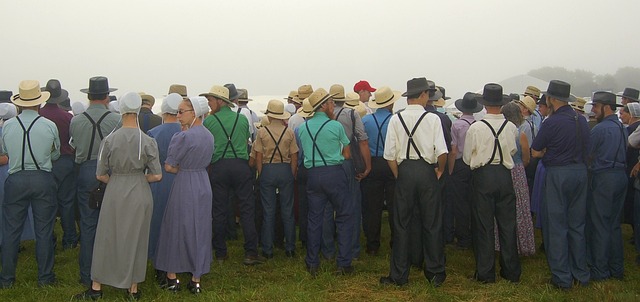The Amish, a traditionalist Christian group, adhere to a set of strict religious beliefs and practices that guide their way of life. As part of their commitment to simplicity, humility, and separation from the modern world, the Amish have a number of prohibitions in place. These restrictions encompass various aspects of technology, fashion, entertainment, and social norms. In this introduction, we will explore some of the key elements that the Amish community forbids.
Table of Contents
The Amish Prohibition on Technology
The Amish are a unique religious group known for their simple way of life and rejection of modern technology. They live in close-knit communities and adhere to a set of strict rules and traditions that have been passed down through generations. One of the most well-known aspects of Amish life is their prohibition on technology.
The Amish believe that technology can be a distraction from their faith and can lead to a loss of community and family values. They see technology as a temptation that can pull them away from their traditional way of life and the values they hold dear. As a result, they have chosen to live without many of the modern conveniences that most people take for granted.
One of the most notable technologies that the Amish forbid is electricity. They believe that electricity connects them to the outside world and can lead to a loss of self-sufficiency. Instead, they rely on alternative sources of power such as gas, oil, or propane. This means that they do not have televisions, computers, or other electronic devices in their homes. Instead, they spend their time engaging in activities that strengthen their community and their faith.
In addition to electricity, the Amish also forbid the use of cars. They believe that cars promote individualism and can lead to a loss of community. Instead, they rely on horse-drawn buggies or bicycles for transportation. This not only allows them to maintain their sense of community but also helps to reduce their impact on the environment.
Another technology that the Amish forbid is the internet. They believe that the internet can expose them to outside influences and can lead to a loss of their traditional values. Instead, they rely on face-to-face communication and traditional forms of media such as newspapers and books. This allows them to control the information that they are exposed to and helps to maintain their sense of community and faith.
While the Amish do have some restrictions on technology, it is important to note that they are not completely cut off from the modern world. Many Amish communities have embraced certain forms of technology that they believe can be used in a way that aligns with their values. For example, some Amish communities allow the use of cell phones for emergencies or business purposes. However, these phones are typically kept in a central location and are not used for personal entertainment.
Overall, the Amish prohibition on technology is rooted in their desire to maintain their traditional way of life and their strong sense of community. They believe that technology can be a distraction and can lead to a loss of their values. While they do make some exceptions for certain forms of technology, they are committed to living a simple and self-sufficient lifestyle that is free from the distractions of the modern world.
Forbidden Modern Amenities in Amish Life

The Amish are known for their simple and traditional way of life. They have a set of rules and guidelines that govern their daily activities, and one of the most notable aspects of their lifestyle is the list of modern amenities that they forbid. These forbidden modern amenities are seen as distractions from their faith and can potentially lead to a loss of community and family values.
One of the most well-known modern amenities that the Amish forbid is electricity. The use of electricity is seen as a temptation that can lead to a dependence on technology and a detachment from the natural world. Instead, the Amish rely on alternative sources of power such as gas lamps, wood-burning stoves, and hand tools. This not only keeps them connected to nature but also fosters a sense of self-sufficiency and simplicity.
In addition to electricity, the Amish also forbid the use of telephones. They believe that telephones can disrupt the close-knit community they have built and can lead to unnecessary communication with the outside world. Instead, the Amish rely on face-to-face interactions and handwritten letters to stay connected with their loved ones. This not only strengthens their relationships but also encourages a slower pace of life and a focus on personal connections.
Another modern amenity that the Amish forbid is the use of cars. The Amish believe that cars promote individualism and can lead to a loss of community spirit. Instead, they rely on horse-drawn buggies and bicycles for transportation. This not only reduces their carbon footprint but also encourages physical activity and a sense of shared responsibility within the community.
The Amish also forbid the use of television, radio, and the internet. They believe that these forms of media can expose them to worldly influences and can distract them from their faith. Instead, the Amish prioritize activities such as reading, storytelling, and spending time with family and friends. This not only fosters a sense of togetherness but also allows them to focus on their spiritual growth and personal development.
It is important to note that the Amish do not forbid these modern amenities out of a sense of superiority or judgment. Instead, they see these restrictions as a way to preserve their way of life and maintain their strong sense of community. By avoiding these distractions, the Amish are able to focus on what they value most: faith, family, and simplicity.
In conclusion, the Amish forbid a number of modern amenities in order to maintain their traditional way of life. From electricity to cars, telephones to television, these restrictions are seen as a way to preserve their faith and foster a strong sense of community. While these restrictions may seem extreme to some, they are an integral part of the Amish way of life and contribute to their unique and close-knit community.
Amish Restrictions on Fashion and Clothing
The Amish community is known for its strict adherence to traditional values and practices. One area where this is particularly evident is in their restrictions on fashion and clothing. The Amish have a unique dress code that sets them apart from the modern world. In this article, we will explore what the Amish forbid when it comes to fashion and clothing.
First and foremost, the Amish believe in modesty. They view clothing as a way to express their commitment to their faith and to separate themselves from the outside world. As a result, they have a set of guidelines that dictate what is acceptable and what is not. For example, women are expected to wear dresses that cover their knees and have long sleeves. They are also required to wear a head covering, such as a bonnet or a prayer cap. Men, on the other hand, are expected to wear pants that are not too tight and shirts with buttons. They are also required to wear a hat when they are outside.
In addition to modesty, the Amish also have restrictions on the types of fabrics and colors that can be used in their clothing. They prefer natural fibers, such as cotton or wool, and avoid synthetic materials like polyester. This is because they believe in living a simple and sustainable lifestyle, and natural fibers are seen as more environmentally friendly. As for colors, the Amish tend to stick to muted tones, such as black, gray, and navy blue. Bright colors and patterns are generally avoided, as they are considered too flashy and attention-seeking.
Another aspect of Amish fashion that is worth mentioning is the use of fasteners. The Amish do not use buttons or zippers in their clothing. Instead, they opt for more traditional methods of fastening, such as hooks and eyes or straight pins. This is in line with their desire to live a simple and self-sufficient lifestyle. It also reflects their belief in the importance of community and the rejection of modern conveniences.
It is important to note that these restrictions on fashion and clothing are not meant to be oppressive or restrictive. Rather, they are seen as a way to maintain the Amish way of life and to preserve their cultural identity. The Amish take pride in their distinctive dress and see it as a way to show their commitment to their faith and their community.
While the Amish dress code may seem strict and outdated to some, it is important to respect their choices and understand the reasons behind them. The Amish have chosen to live a simple and traditional lifestyle, and their clothing is just one aspect of that. By adhering to their dress code, they are able to maintain their unique identity and preserve their values.
In conclusion, the Amish have several restrictions on fashion and clothing. They prioritize modesty and choose clothing that reflects their commitment to their faith. They prefer natural fibers and muted colors, and they avoid modern fasteners. These restrictions are not meant to be oppressive, but rather to preserve their cultural identity and way of life. It is important to respect and understand the choices of the Amish community, even if they may seem different from our own.
The Amish Stance on Education and Higher Learning
The Amish community is known for its strict adherence to traditional values and a simple way of life. One area where this is particularly evident is in their stance on education and higher learning. The Amish believe that education should be focused on practical skills and knowledge that will benefit the community as a whole.
Unlike mainstream society, the Amish do not place a high value on formal education. They believe that too much emphasis on book learning can lead to pride and a sense of superiority over others. Instead, they prioritize hands-on learning and practical skills that can be applied to everyday life.
In Amish communities, education is primarily provided through the Amish school system. These schools are typically one-room buildings where children of all ages learn together. The curriculum is focused on basic reading, writing, and arithmetic, as well as practical skills such as woodworking, gardening, and cooking.
The Amish believe that education should be a lifelong process, not something that ends with formal schooling. They value the importance of learning from experience and passing down knowledge from one generation to the next. This is why apprenticeships are highly valued within the Amish community. Young people are encouraged to learn a trade or skill from a more experienced member of the community, allowing them to gain practical knowledge and contribute to the community’s well-being.
Higher education, such as attending college or university, is generally discouraged within the Amish community. The Amish believe that higher education can lead to a desire for material wealth and a focus on individual success, which goes against their core values of simplicity and community. They also worry that exposure to the outside world and different ideas may lead to a weakening of their faith and traditions.
However, this does not mean that the Amish are completely opposed to learning beyond the basic education provided in their schools. Many Amish individuals pursue further education through alternative means. Some may take correspondence courses or attend vocational schools to learn a specific trade. Others may participate in workshops or seminars to expand their knowledge in a particular area of interest.
The Amish also place a strong emphasis on self-education. They believe that individuals have a responsibility to continually seek knowledge and improve themselves. This can be seen in the Amish practice of reading and studying religious texts, as well as other books that provide practical knowledge or insights into the world.
Overall, the Amish stance on education and higher learning is rooted in their commitment to simplicity, community, and practicality. They believe that education should be focused on skills that benefit the community and that learning should be a lifelong process. While higher education is generally discouraged, the Amish still value self-education and the pursuit of knowledge in practical and meaningful ways.
Conclusion
The Amish forbid certain modern technologies, such as electricity, cars, and televisions. They also have strict rules regarding dress, education, and social interactions. These restrictions are based on their religious beliefs and the desire to maintain a simple and traditional way of life.
For licensing reasons, we must provide the following notice: This content was created in part with the help of an AI.


